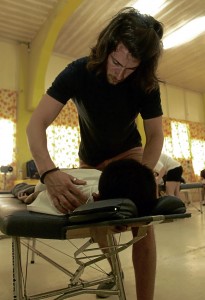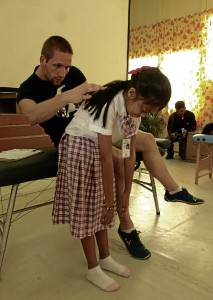
Chiropractic students from the Royal Melbourne Institute of Technology (RMIT) left the Philippines with more confidence after undertaking their internship and medical missions here.
Organized by Intercare, its local partner healthcare center, the two-week program was aimed at helping the students treat as many patients as possible in order to meet their quota for graduation. The program consisted of attending outreach medical missions, treating professional athletes and observing Intercare clinics. The students served a total of 632 children and adults from indigent communities and 96 sports people.
“It’s not compulsory to go overseas but we volunteered, we’re the more adventurous group,” said Anthony Muré, 22, RMIT group leader.
Anthony said the Philippines had a good reputation among Australians as a travel destination. Although there wasn’t much time for sight-seeing, he gained a lot of experience with the medical missions in Aurora (hosted by Sen. Edgardo Angara), Subic (organized by chair Roberto Garcia) and Taguig City (organized by Sen. Pia Cayetano).
The missions screened public school children for scoliosis, an abnormal curving of the spine, and the adults for other postural problems. The RMIT students examined, diagnosed and provided chiropractic treatments. Anthony estimated that they treated an average of 91 patients each.
He observed that their complaints were common, namely, neck and low back pain. Unlike the professionals who derive their low back pain from sitting all day, slouched over the computer or driving for long hours, the people from the indigent communities also got the same problems because of overuse of muscles and joints.

“The most important thing I’ve learned is experience. We’ve been working for our degree for nearly five years. We have a lot of knowledge but we need to develop it by using it appropriately,” Anthony said.
“Since being in the Philippines, our knowledge has grown exponentially with the number of people we’ve treated.”
Anthony plans to return soon and immerse himself in the dive sites and beaches.
With a sports science background Yngve Rogstadkjaernet, 28, was attracted to the Philippine program because it provided opportunities to treat professional athletes. With the help of Jose Cojuangco Sr., president of the Philippine Olympic Committee, the Australian interns treated volleyball players, triathletes, martial artists and weightlifters.
Through this mission, the athletes were taught stretching, injury prevention and athletic taping. Likewise, Intercare documented their injuries and complaints to help design a preventive and therapeutic program for the elite athletes.
Yngve pointed out that Intercare’s system is unique. “Even in a multidiscipline clinic in Australia, you make a separate appointment with the chiropractor and the massage therapist. Here, the patient stays in one room and all the practitioners go inside. Everyone will work with one patient. The staff has been super friendly,” Yngve said.
He found the medical missions a heart-tugging experience. “Most of us have seen 200 patients in a whole year. Here, we saw a total of 728 in two weeks.
“I’m hoping that the university would do this next year for the next group because it’s something different. In Australia, the public healthcare system is so good you don’t feel a lot of problems. There is no such thing as not going to the doctor because you can’t afford it,” Yngve said.
“In Taguig, the people had chronic pains, but couldn’t do anything about it because they don’t have access to medical care. We got to help them even just a little bit,” he added.
Although the patients were poor, they were not found lacking in warmth and gratitude.
“When we were about to leave, they followed our bus to the driveway, laughing and smiling. It was great.”
On the significance of this program, Martin Camara, CEO of Intercare, cited a World Health Organization study that four out of five people suffer from low back pain, especially among the poor who make a living through manual labor.
“Those suffering from conditions like these can then lose the ability to provide for themselves and their families,” he explained. “The Intercare-RMIT mission helped people who otherwise would not have been able to access chiropractic care. The mission also allowed us to gather data on the incidences of lower back pain, scoliosis and other neuromuscolo-skeletal conditions. This will then help local governments design and implement preventative healthcare programs.”
Plans are afoot for annual internship programs in the Philippines between RMIT and Intercare. “We are looking for partners in different organizations for future missions so more Filipinos can benefit from chiropractic care,” Camara said.

